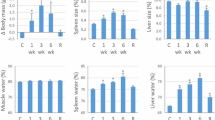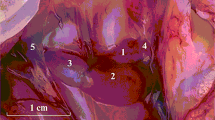Summary
The effect of hypoxia was studied in cold (15°C) and warm (30°C) acclimated goldfish. The hypoxic thresholds, defined as the lowest sustainablePO2 were found to be 1.6 and 4.0 kPa O2 at, respectively, 15°C and 30°C. At these levels the fish did not loose either weight or appetite over a 2-months period. While during starvation under normonic conditions a significant weight loss and breakdown of lactate dehydrogenase (90%) was observed, no such changes were found in fed hypoxic animals.
In red lateral muscle, white epaxial muscle and liver of goldfish from 4 differently acclimated groups the maximal activities were measured of: glycogen phosphorylase, hexokinase, malate dehydrogenase, glycerol-3-P dehydrogenase, glucose-6-P dehydrogenase, malic enzyme, succinate oxidase, pyruvate carboxylase, phosphoenol-pyruvate carboxykinase, fructose-bisphosphatase and glucose-6-phosphatase.
Thermal compensation, according to Precht's typology, was predominantly observed in red muscle and to a lesser extent in white muscle. The liver glucose-6-P dehydrogenase showed a strong inverse response, which points to enhanced synthetic activity at the higher temperature.
Hypoxia acclimation exerted weaker responses at 15°C than at 30°C. Changes in liver enzyme activities suggest depressed protein synthesis and enhanced gluconeogenesis in hypoxic animals. In muscle of 30°C-acclimated goldfish hypoxia induces a significant increase of succinate oxidase activity, indicating adaptation of the aerobic energy metabolism.
The occurrence of pyruvate carboxylase, never before observed in vertebrate muscle, probably plays an important role in pyruvate catabolism. Because its action produces oxalo-acetate, the enzyme may stimulate pyruvate oxidation and thus prevent early lactate accumulation.
Since all gluconeogenic enzymes were shown to be active in goldfish muscle, the possible occurrence of gluconeogenesis in muscle (albeit at low rate) must be accepted.
Enzyme activities in goldfish muscle were compared with literature data for a number of other fish species. This comparison indicates that maximal glycolytic flux in goldfish muscle tissue is rather low, although muscular glycogen levels are very high. It is suggested that this is part of the gold-fish's strategy to cope with hypoxia.
Similar content being viewed by others
Abbreviations
- EC :
-
enzyme nomenclature classification number
- FDP-ase :
-
fructose-disphosphatase
- G3PDH :
-
glycerol-3-P dehydrogenase
- G3P-OX :
-
glycerol-3P oxidase
- G6P-ase :
-
glucose-6-phosphatase
- G6PDH :
-
glucose-6-P dehydrogenase
- GPT :
-
glutamate-pyruvate transaminase
- HEX :
-
hexokinase
- HMS :
-
hexosemonophosphate shunt
- LDH :
-
lactate dehydrogenase
- MDH :
-
malate dehydrogenase
- ME :
-
malic enzyme
- PCL :
-
pyruvate carboxylase
- PEPCK :
-
phosphoenol-pyruvate carboxykinase
- PFK :
-
phospho-fructokinase
- PHOS :
-
phosphorylase
- PK :
-
pyruvate kinase
- SOX :
-
succinate oxidase
References
Bücher T, Pfleiderer G (1955) Pyruvate kinase from muscle. Meth Enzymol 1: 435–440
Brooks GA, Gaesser GA (1980) End points of lactate and glucose metabolism after exhausting exercise. J Appl Physiol 49: 1057–1069
Childress C, Sacktor B (1970) Regulation of glycogen metabolism in insect flight muscle. Purification and properties of phosphorylase in vitro and in vivo. J Biol Chem 245:2927–2936
Connett RJ (1979) Glyconeogenesis from lactate in frog striated muscle. Am J Physiol 237: C231-C236
Crabtree B, Higgins SJ, Newsholme EA (1972) The activities of pyruvate carboxylase, phosphoenolpyruvate carboxykinase and fructose diphosphatase in muscles from vertebrates and invertebrates. Biochem J 130: 391–396
Crabtree B, Newsholme EA (1972) The activities of phosphorylase, hexokinase, phosphofructokinase, lactate dehydrogenase and the glycerol-3-phosphate dehydrogenases in muscles from vertebrates and invertebrates. Biochem J 126:49–58
Felig P, Wahren J (1971) Aminoacid metabolism in man. J Clin Invest 50:2703–2714
Fry FEJ (1947) Effects of the environment on animal activity. University Toronto Studies Biol Ser 55: 1–62
Garland R, Cori C (1972) Separation of phospholipids from glucose-6-phosphatase by gel-chromatography. Specificity of phospholipid reactivation. Biochemistry 11: 4712–4718
Geiger R, Bessmann S (1972) Protein determination by Lowry's method in the presence of sulfhydryl reagents. Anal Biochem 49: 467–473
Gornall AG, Bardawill CJ, David MM (1949) Determination of serum proteins by means of the biuret reaction. J Biol Chem 177: 751–766
Greaney GS, Place AR, Cashon RE, Smith G, Powers DA (1980) Time course of changes in enzyme activities and blood respiratory properties of Killifish during long-term acclimation to hypoxia. Physiol Zool 53: 136–144
Hansford RG (1972) Some properties of pyruvate and 2-oxoglutarate oxidation by blowfly fligh muscle mitochondria. Biochem J 127: 271–283
Hazel J, Prosser CL (1970) Interpretation of inverse acclimation to temperature. Z Vergl Physiol 67: 217–228
Hermann RB, Warren CE, Douderoff P (1962) Influence of oxygen concentration on the growth of juvenile Coho Salmon. Trans Am Fish Soc 91: 155–167
Hochachka PW (1980) Living without oxygen. Harvard University Press, Cambridge
Hsu RY, Lardy HA (1969) Malic enzyme. Meth Enzymol 13: 230–235
Hudlická O, Pette D, Staudte H (1973) The relation between blood flow and enzymatic activity in slow and fast muscles during development. Pflügers Arch 343: 341–356
Huisman EA (1974) Optimation of growth of carp, Cyprinus carpio L. PhD Thesis, Polytechn. School Wageningen, The Netherlands
Johnston IA (1975) Anaerobic metabolism in the carp,Carassius carassius L. Comp Biochem Physiol 51B: 235–241
Johnston IA, Goldspink G (1973) Some effects of prolonged starvation on the metabolism of the red and white myotomal muscles of the plaice,Pleuronectes platessa. Mar Biol 19: 348–353
Johnston IA, Bernard LM (1982) Ultrastructure and metabolism of skeletal muscle fibres in the tench. Effects of long-term acclimation to hypoxia. Cell Tissue Res 227: 179–199
Kanungo MS, Prosser CL (1959) Physiological and biochemical adaptation of goldfish to cold and warm temperature. I. Standard and active oxygen consumption of cold and warm acclimated goldfish at various temperatures. J Cell Comp Physiol 54: 259–263
Kinnula VL (1976) Mitochondrial cytochrome concentration in rat heart and liver as a consequence of different hypoxia periods. Acta Physiol Scand 96: 417–421
Kornberg A (1955) Lactate dehydrogenase of muscle. Meth Enzymol 1: 441–443
Lehman J (1970) Veränderungen der Enzymaktivitäten nach einem Wechsel der Adaptationstemperatur, untersucht am Seitenrumpfmuskel des Goldfisches (Carassius auratus L.). Int Rev Ges Hydrobiol 55: 763–781
Lomholt JP, Johansen K (1979) Hypoxia acclimation in carp. How it effects O2 uptake, ventilation and O2 extraction from water. Physiol Zool 52: 38–50
Lowry H, Rosebrough AL, Farr AL, Randall RJ (1951) Protein measurement with the Folin phenol reagent. J Biol Chem 193: 265–275
Mela L, Goodwin CW, Miller LD (1977) In vivo adaptation of O2 utilisation to O2 availability: comparison of adult and newborn mitochondria. In: Jöbsis F (ed) Oxygen and physiological function. Prof Information Library, Dallas, pp 283–291
Molé PA, Baldwin HM, Terjung RL, Holloszy JO (1973) Enzymatic pathways of pyruvate metabolism in skeletal muscle: adaptation to exercise. Am J Physiol 224: 50–54
Moon TW, Johnston IA (1980) Stavation and the activities of glycolytic and gluconeogenetic enzymes and skeletal muscle and liver of the plaice,Pleuronectes platessa. J Comp Physiol 36: 31–38
Mourik J (1982) Anaerobic metabolism in red skeletal muscle of goldfish (Carassius auratus L.). PhD thesis, State University of Leiden, The Netherlands
Newsholme EA, Crabtree B (1970) The role of fructose-1.6.-diphosphatase in the regulation of glycolysis in skeletal muscle. FEBS Lett 7: 195–198
Opie LH, Newsholme EA (1967) The activities of fructose-1.6-diphosphatase, phosphofructokinase and phosphoenol pyruvate carboxykinase in white muscle and red muscle. Biochem J 103: 391–399
Pette D, Bücher T (1963) Porportionskonstante Gruppen in Beziehung zur Differenzierung der Enzymaktivitätsmuster von Skelet-Muskeln des Kaninchens. Hoppe-Seylers Z Phys Chem 331: 181–195
Precht H (1968) Der Einfluß ‘normaler’ Temperaturen auf Lebensprozesse bei wechselwarmen Tieren unter Ausschluß der Wachstums- und Entwicklungsprozesse. Helgoländer Wiss Meeresunters 18: 487–548
Prosser CL (1973) Comparative animal physiology, 3rd edn. Saunders, Philadelphia
Randall DJ (1970) Gas exchange in fish. In: Hoar WS, Randall DJ (eds) Fish physiology vol VI. Academic Press, New York, pp 253–287
Saubert CW, Armstrong RB, Shepard RH, Gollnick PD (1973) Anaerobic enzyme adaptations to sprint training in rats. Pflügers Arch 341: 305–312
Shepard MP (1955) Resistance and tolerance of young speckled trout (Salvelinus fontinalis) to oxygen lack, with special reference to low oxygen acclimation. J Fish Res Board Can 12: 387–446
Smit H, Berg RJ van den, Kijne-den Hartog I, Rozing J (1974) Some experiments on thermal acclimation in the goldfish (Carassius auratus L.). Neth J Zool 24: 32–49
Susheela L, Suamder AR, Ramasarma T (1972) Differential alteration of enzymes under hypobaria and hypoxia. FEBS Lett 25: 295–297
Thillart G van den (1977) Influence of oxygen availability on the energy metabolism of goldfish. Carassius auratus L. PhD thesis, State University of Leiden, The Netherlands
Thillart G van den, Modderkolk J (1978) The effects of acclimation temperature on the activation energies of state III respiration and on the unsaturation of membrane lipids of goldfish mitochondria. Biochem Biophys Acta 501: 38–51
Thillart G van den, Kesbeke F, Waarde A van (1980) Anaerobic energy-metabolism of goldfish,Carassius auratus (L.). Influence of hypoxia and anoxia on phosphorylated compounds and glycogen. J Comp Physiol 136: 45–52
Wardle CS (1978) Non-release of lactic acid from anaerobic swimming muscle of plaicePleuronectes platessa L.: a stress reaction. J Exp Biol 77: 141–155
Weber RE, Lykkeboe G (1978) Respiratory adaptations in carp blood. Influences of hypoxia, red cell organic phosphates, divalent cations and CO2 on hemoglobin affinity. J Comp Physiol 128: 127–137
Wood SC, Johansen K (1972) Adaptation to hypoxia by increased HbO2 affinity and decreased red-cell ATP concentration. Nature 237: 278–279
Zammit VA, Bei L, Newsholme EA (1978) Maximum activities and effects of fructose biphosphate on pyruvate kinase from muscles of vertebrates and invertebrates in relation to the control of glycolysis. Biochem J 174: 989–998
Author information
Authors and Affiliations
Rights and permissions
About this article
Cite this article
van den Thillart, G., Smit, H. Carbohydrate metabolism of goldfish (Carassius auratus L.). J Comp Physiol B 154, 477–486 (1984). https://doi.org/10.1007/BF02515152
Accepted:
Issue Date:
DOI: https://doi.org/10.1007/BF02515152




